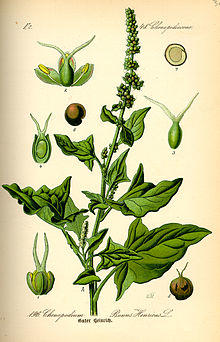| Good-King-Henry | |
|---|---|
 | |
| Scientific classification | |
| Kingdom: | Plantae |
| Clade: | Tracheophytes |
| Clade: | Angiosperms |
| Clade: | Eudicots |
| Order: | Caryophyllales |
| Family: | Amaranthaceae |
| Genus: | Blitum |
| Species: | B. bonus-henricus |
| Binomial name | |
| Blitum bonus-henricus (L.) Rchb. | |
| Synonyms | |
| see text | |
Blitum bonus-henricus (syn. Chenopodium bonus-henricus), also called Good-King-Henry,[1] poor-man's asparagus, perennial goosefoot, Lincolnshire spinach, Markery,[2] English mercury, or mercury goosefoot,[3] is a species of goosefoot which is native to much of central and southern Europe.
Good-King-Henry has been grown as a vegetable in cottage gardens for hundreds of years, although this dual-purpose vegetable is now rarely grown and the species is more often considered a weed.
Description
It is an annual or perennial plant growing up to 400–800 mm tall. The leaves are 50–100 mm long and broad, triangular to diamond-shaped, with a pair of broad pointed lobes near the base, with a slightly waxy, succulent texture. The flowers are produced in a tall, nearly leafless spike 100–300 mm long; each flower is very small (3–5 mm diameter), green, with five sepals. The seeds are reddish-green, 2–3 mm diameter.
Taxonomy
The species was described in 1753 by Carl Linnaeus as Chenopodium bonus-henricus in Species Plantarum.[4] Until 2012, the species was usually included in genus Chenopodium, but molecular genetical research revealed that it does not really belong to this genus. It seems to be more closely related to the genus Spinacia, and is now placed in the genus Blitum in the tribe Anserineae.[5][6][7] The scientific name Blitum bonus-henricus was first used by Ludwig Reichenbach in 1832.[8]
Synonyms basing on the same type specimen are: Agathophytum bonus-henricus (L.) Moq., Anserina bonus-henricus (L.) Dumort., Atriplex bonus-henricus (L.) Crantz, Chenopodium bonus-henricus L., Orthospermum bonus-henricus (L.) Schur, and Orthosporum bonus-henricus (L.) T. Nees.[9] Heterotypic synonyms are: Blitum perenne Bubani, Chenopodium hastatum St.-Lag., Chenopodium ruderale Kit. ex Moq., Chenopodium ruderale St.-Lag., Chenopodium sagittatum Lam., Chenopodium spinacifolium Stokes, Chenopodium triangulare Dulac, Chenopodium triangularifolia Gilib., and Orthosporum unctuosum Montandon.[10]
Cultivation and uses
It should be planted in a fertile, sunny location[11] which is free from perennial weeds. Seeds must be cold-stratified in order to germinate.[11] The plants should be regularly weeded and well watered. Typically, very little is produced in the first season. Good King Henry does not respond well to transplantation.
The foliage can be cut in autumn, and a mulch, such as leaf mould or well-rotted compost applied to the plot.
Culinary uses
Cropping can begin in spring. Some of the new shoots can be thinned out as they appear (usually from mid spring to early summer) and cooked like asparagus. All cutting should then cease so that shoots are allowed to develop. The succulent triangular leaves may be harvested a few at a time until the end of August and cooked like spinach.
References
- ^ "BSBI List 2007". Botanical Society of Britain and Ireland. Archived from the original (xls) on 2015-01-25. Retrieved 2014-10-17.
- ^ Great British Bites: Lincolnshire spinach Times Online, 13 May 2008
- ^ Grieve, M. (2014). "Goosefoots". A Modern Herbal. Botanical.com. Retrieved 17 May 2015.
- ^ Carl Linnaeus: Species Plantarum. Vol. 1, Impensis Laurentii Salvii, Holmiae 1753, p. 218.
- ^ Susy Fuentes-Bazan, Pertti Uotila, Thomas Borsch: A novel phylogeny-based generic classification for Chenopodium sensu lato, and a tribal rearrangement of Chenopodioideae (Chenopodiaceae). In: Willdenowia. Vol. 42, No. 1, 2012, p. 18.
- ^ "Blitum bonus-henricus". Germplasm Resources Information Network (GRIN). Agricultural Research Service (ARS), United States Department of Agriculture (USDA). Retrieved 2016-11-04.
- ^ Blitum bonus-henricus at National Center for Biotechnology Information (NCBI), accessed 2014-11-26.
- ^ Heinrich Gottlieb Ludwig Reichenbach: Flora Germanica excursoria. Vol. 2, Cnobloch, Leipzig, 1832, Vol 2, p. 582. online.
- ^ "Chenopodium bonus-henricus". Tropicos. Missouri Botanical Garden. Retrieved 2014-11-25.
- ^ "Chenopodium bonus-henricus". World Checklist of Selected Plant Families (WCSP). Royal Botanic Gardens, Kew. Retrieved 2014-11-25 – via The Plant List.
- ^ a b Graham, G. Scott. Growing & Using Good King Henry.